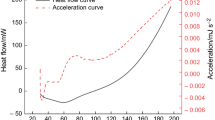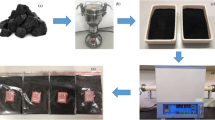Abstract
Using simultaneous thermal analysis-Fourier transform infrared spectroscopy, we analyzed the oxidation and exothermic behaviors of six types of coal based on various factors, such as characteristic temperature, heat release, and gas release, to establish a foundation for prevention and control of spontaneous combustion in six types of coal in China. According to the experimental results, a decrease in the metamorphic grade of coal causes an increase in the amount of volatile matter, the heat release rate, and the total heat released. The apparent exothermic onset temperature and initial temperature for the release of H2O, CO2, CO, and CH4 during the nonisothermal oxidation process of coal took place earlier, indicating that the oxidation reaction occurred more easily in lower-grade coal, increasing the hazards of spontaneous combustion. Moreover, when decomposing, coal releases large amounts of CH4, which may cause gas explosions in coal mines. Therefore, technology facilitating the detection of CH4 and prevention of explosions should be developed for use in the coal industry.









Similar content being viewed by others
Abbreviations
- A ad :
-
Ash content (%)
- FCad :
-
Fixed carbon content (%)
- M ad :
-
Moisture content (%)
- T 1 :
-
Characteristic temperature of maximum evaporation of water and desorption of gases (°C)
- T 2 :
-
Characteristic temperature of maximum oxidization mass gain (°C)
- T 3 :
-
Characteristic temperature of ignition point (°C)
- T 4 :
-
Characteristic temperature of maximum mass loss rate (°C)
- T 5 :
-
Characteristic temperature of terminal residual (°C)
- T D1 :
-
Temperature at the maximum endothermic reaction with evaporation of water and desorption of gases (°C)
- T D2 :
-
Exothermic onset temperature of oxidation reaction (°C)
- T D3 :
-
Temperature at the maximum heat release rate (°C)
- T D4 :
-
Temperature at the end of the combustion reaction (°C)
- V ad :
-
Volatile contents (%)
References
Web of The Central People’s Government of the People’s Republic of China. (2014). http://www.gov.cn/xinwen/2014-10/10/content_2762334.htm.
Web of The Central People’s Government of the People’s Republic of China. (2014). http://www.gov.cn/xinwen/2014-11/26/content_2783534.htm.
Wen H, Zhang F, Jin Y, Liu W. Experiment research on effect of sulfur on characteristic parameters of coal spontaneous combustion. Coal Saf. 2011;42:5–7 (in Chinese).
Pandey J, Mohalik NK, Mishra RK, Khalkho A, Kumar D, Singh VK. Investigation of the role of fire retardants in preventing spontaneous heating of coal and controlling coal mine fires. Fire Technol. 2015;51:227–45.
Qi X, Wei C, Li Q, Zhang L. Controlled-release inhibitor for preventing the spontaneous combustion of coal. Nat Hazards. 2016;82:891–901.
Zhou F, Wang D, Zhang Y, Zhang Y, Li X. Practice of fighting fire and suppressing explosion for a super-large and highly gassy mine. J China Univ Ming Technol. 2007;17:459–63.
Xie Z, Li X, Liu M. Application of three-phase foam technology for spontaneous combustion prevention in Longdong coal mine. Proc Eng. 2011;26:63–9.
Mao Z, Zhu H, Zhao X, Sun J, Wang Q. Experimental study on characteristic parameters of coal spontaneous combustion. Proc Eng. 2013;62:1081–6.
Deng J, Xu J, Zhang X, Wen H, Li L. Investigation on the relation of coal low temperature oxidation and the size of coal sample. Coal. 1999;8:13–5.
Baris K, Kizgut S, Didari V. Low-temperature oxidation of some Turkish coals. Fuel. 2012;93:423–32.
Xin H, Wang D, Qi X, Qi G, Dou G. Structural characteristics of coal functional groups using quantum chemistry for quantification of infrared spectra. Fuel Process Technol. 2014;118:287–95.
Wang H, Dlugogorski BZ, Kennedy EM. Theoretical analysis of reaction regimes in low-temperature oxidation of coal. Fuel. 1999;78:1073–81.
Méndez LB, Borrego AG, Martinez-Tarazona MR, Menéndez R. Influence of petrographic and mineral matter composition of coal particles on the combustion reactivity. Fuel. 2003;82:1875–82.
Tahmasebi A, Yu J, Han Y, Li X. A study of chemical structure changes of Chinese lignite during fluidized-bed drying in nitrogen and air. Fuel Process Technol. 2012;101:85–93.
Li B, Chen G, Zhang H, Sheng C. Development of non-isothermal TGA-DSC for kinetics analysis of low temperature coal oxidation prior to ignition. Fuel. 2014;118:385–91.
Xie J, Xue S, Cheng W, Wang G. Early detection of spontaneous combustion of coal in underground coal mines with development of an ethylene enriching system. Int J Coal Geol. 2011;85:123–7.
Ozbas KE, Kök MV, Hicyilmaz C. DSC study of the combustion properties of Turkish coals. J Therm Anal Calorim. 2003;71:849–56.
Li L, Jiang D, Beamish BB. Calculation of ignition times under adiabatic conditions by activation energy. J China Coal Soc. 2010;35:802–5.
Beamish BB, Barakat MA, George JDS. Spontaneous-combustion propensity of New Zealand coals under adiabatic conditions. Int J Coal Geol. 2001;45:217–24.
Guo Z, Bai Z, Bai J, Wang Z, Li W. Synergistic effects during co-pyrolysis and liquefaction of biomass and lignite under syngas. Prog Energy Combust Sci. 2015;119:2133–40.
Deng J, Wang K, Zhang Y, Yang H. Study on the kinetics and reactivity at the ignition temperature of Jurassic coal in North Shaanxi. J Therm Anal Calorim. 2014;118:417–24.
Meriste T, Yörük CR, Trikkel A. TG–FTIR analysis of oxidation kinetics of some solid fuels under oxy-fuel conditions. J Therm Anal Calorim. 2013;114:483–9.
Acknowledgements
Financial support for this work was provided by two key projects of the National Natural Science Foundation of China (Nos. 51134019 and 5150418), and the Natural Science Foundation of Shaanxi Province (CN) (No. 2014JM7276) is also gratefully acknowledged.
Author information
Authors and Affiliations
Corresponding author
Rights and permissions
About this article
Cite this article
Wang, C., Yang, Y., Tsai, YT. et al. Spontaneous combustion in six types of coal by using the simultaneous thermal analysis-Fourier transform infrared spectroscopy technique. J Therm Anal Calorim 126, 1591–1602 (2016). https://doi.org/10.1007/s10973-016-5685-2
Received:
Accepted:
Published:
Issue Date:
DOI: https://doi.org/10.1007/s10973-016-5685-2




